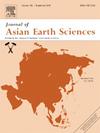Adsorption behavior of H2 in forsterite micro-pores with genetic implications for H2 seismic geochemical anomalies
IF 2.7
3区 地球科学
Q2 GEOSCIENCES, MULTIDISCIPLINARY
引用次数: 0
Abstract
The presence and properties of hydrogen gas (H2) in the Earth’s deep interior provide valuable insights into the role of H2 geochemistry in monitoring seismic activities. Experiment results have shown that serpentinization of olivine is the primary mechanism of natural H2 production on the Earth. Therefore, the characteristics of H2 storage and migration within the Earth are significant for understanding the mechanisms behind seismic geochemical precursor. In this study, the Grand Canonical Monte Carlo method combined with molecular dynamics is applied to simulate the adsorption behaviors and characteristics of H2 in slit-like pores of forsterite (an free-Fe olivine end-number), under different temperature–pressure conditions (300–1000 K and 0–100 MPa) and pore sizes (5–20 Å). The results indicated that adsorption of H2 in forsterite pores is physical adsorption mainly controlled by van der Waals force. The amount of heat released by adsorption of H2 in forsterite pores (isosteric heat) positively correlates with temperature and pore size. The increased pressure and pore size will increase the amount of H2 adsorbed (Nexcess) in the forsterite pores and temperature is negatively correlated with the Nexcess. Our simulations reveal that the interplay between temperature–pressure conditions and the pore size of forsterite significantly influences the adsorption and dissipation of H2 within the deep Earth. This interaction subsequently results in discernible changes to the geochemical signatures of H2 at the Earth’s surface, which are intrinsic controls that allow H2 geochemical characteristics to serve as crucial indicators for monitoring seismic activities.

求助全文
约1分钟内获得全文
求助全文
来源期刊

Journal of Asian Earth Sciences
地学-地球科学综合
CiteScore
5.90
自引率
10.00%
发文量
324
审稿时长
71 days
期刊介绍:
Journal of Asian Earth Sciences has an open access mirror journal Journal of Asian Earth Sciences: X, sharing the same aims and scope, editorial team, submission system and rigorous peer review.
The Journal of Asian Earth Sciences is an international interdisciplinary journal devoted to all aspects of research related to the solid Earth Sciences of Asia. The Journal publishes high quality, peer-reviewed scientific papers on the regional geology, tectonics, geochemistry and geophysics of Asia. It will be devoted primarily to research papers but short communications relating to new developments of broad interest, reviews and book reviews will also be included. Papers must have international appeal and should present work of more than local significance.
The scope includes deep processes of the Asian continent and its adjacent oceans; seismology and earthquakes; orogeny, magmatism, metamorphism and volcanism; growth, deformation and destruction of the Asian crust; crust-mantle interaction; evolution of life (early life, biostratigraphy, biogeography and mass-extinction); fluids, fluxes and reservoirs of mineral and energy resources; surface processes (weathering, erosion, transport and deposition of sediments) and resulting geomorphology; and the response of the Earth to global climate change as viewed within the Asian continent and surrounding oceans.
 求助内容:
求助内容: 应助结果提醒方式:
应助结果提醒方式:


